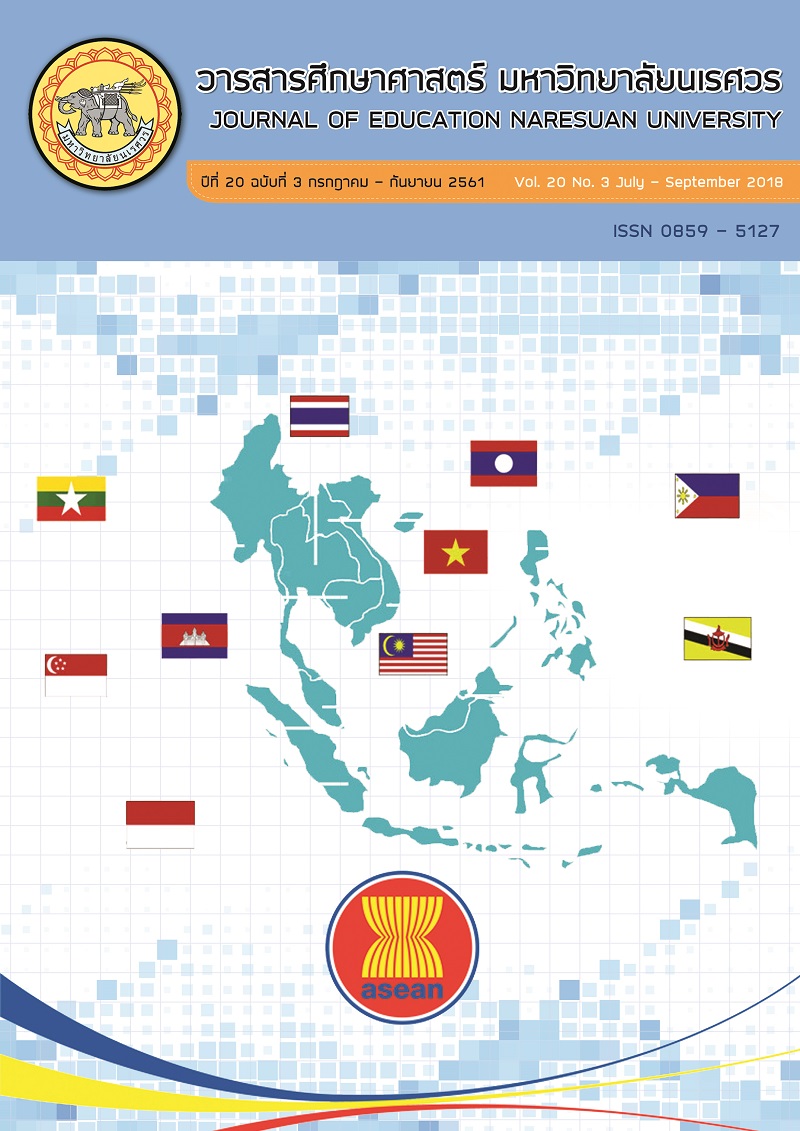การเรียนการสอนโดยใช้สถานการณ์จำลองในผู้เรียนทางวิสัญญีวิทยา; TEACHING AND LEARNING WITH SIMULATION-BASED METHOD IN ANESTHESIOLOGY TRAINEES
Main Article Content
Abstract
ในช่วงทศวรรษที่ผ่านมาการฝึกหัดหัตถการในผู้ป่วยจริงมีข้อจำกัดเนื่องจากกฎหมายคุ้มครองสิทธิผู้ป่วยวิธีการสอนตั้งแต่อดีตจนถึงปัจจุบันจึงมีการพัฒนาขึ้นเป็นลำดับ การสอนโดยใช้สถานการณ์จำลอง (Simulation-based learning) เป็นการสอนอีกวิธีหนึ่งที่นำมาประยุกต์ใช้ในการเรียนการสอนภาคปฏิบัติทางวิสัญญีวิทยา เพื่อตอบสนองต่อแนวคิดการเรียนการสอนในศตวรรษที่ 21 โดยผู้สอนกำหนดวัตถุประสงค์การเรียนรู้ และให้คำปรึกษา ภายใต้พื้นฐานการเรียนรู้ด้วยตนเองของผู้เรียน (Self-directed learning) โดยการรวบรวม และวิเคราะห์ข้อมูล รวมถึงการประเมินตนเอง ภายหลังการเรียนรู้ ซึ่งเป็นเทคนิคการเรียนการสอนที่ได้รับการยอมรับในปัจจุบัน เนื่องจากผลสัมฤทธิ์ทางการเรียนอยู่ในเกณฑ์สูง เป็นการเรียนรู้ที่ผู้เรียนสวมบทบาทสมมติ ท่ามกลางสภาพแวดล้อมที่เสมือนจริงมากที่สุด ผู้เรียนสามารถมีปฏิสัมพันธ์กับเหตุการณ์รอบข้าง จึงเป็นเสมือนกุญแจสำคัญที่ช่วยให้ผู้เรียนข้ามผ่านข้อจำกัดเรื่องสิทธิผู้ป่วยในด้านความยินยอมหรือไม่ต่อการให้ผู้ประกอบวิชาชีพปฏิบัติต่อตน การสอนด้วยสถานการณ์จำลองมีโครงสร้างที่เป็นบรรทัดฐานหรือกิจกรรมหลัก 3 ขั้นตอน คือ 1) การเตรียมการ (Briefing) 2) การเล่นตามสถานการณ์จำลอง (Scenario) 3) การอภิปราย (Debriefing) โดยมุ่งหวังถึงผลลัพธ์สูงสุดของการเรียนรู้ทางคลินิกคือผู้เรียนสามารถแสดงวิธีปฏิบัติงานในสถานการณ์ต่างๆ (shows how) เพื่อนำไปสู่ความปลอดภัยของผู้ป่วยในที่สุด
TEACHING AND LEARNING WITH SIMULATION-BASED METHOD IN ANESTHESIOLOGY TRAINEES
Procedural skills practicing in patient is limited due to the patient rights for decade. So far the instructional methods have been developed for a period of time. A well known ‘simulation-based learning’ (SBL) method is now applied in anesthesiology based on the 21st century concept of education. Teacher is facilitator who set the learning objectives under self-directed learning process. Students gather and analyze the information with self assessment in class. Students can play their role and interact with the simulating environment. This method becomes the solution of patient rights protection in terms of agreement to the practitioner to treat them or not. Teaching with simulated scenarios is a normative framework using 3 main activities: 1) Preparation (Briefing), 2) Hands-on (Scenario), and 3) Discussion (debriefing). The ultimate outcome of clinical teaching is that students can show how to deal with situation. This will lead to an increase the learners’ competency as well as patient safety in real practice.
Article Details
The owner of the article does not copy or violate any of its copyright. If any copyright infringement occurs or prosecution, in any case, the Editorial Board is not involved in all the rights to the owner of the article to be performed.
References
Bhagwat, M. (2012). Simulation and anaesthesia. Indian journal of Anaesthesia, 56(1), 14-20
Bogossian, F., Cooper, S., Cant, R., Beauchamp, A., Porter, J., Kain, V., & FIRST2ACT™ Research Team. (2014). Undergraduate nursing students' performance in recognizing and responding to sudden patient deterioration in high psychological fidelity simulated environments: An Australian multi-centre study. Nurse education today, 34(5),
691-696.
Cate Nicholas. (2014). Teaching with Simulation. In: Kathryn N. H., William B.J., editors, An Introduction to Medical Teaching. Netherlands: Springer.
Chiniara, G., et al. (2013). Simulation in healthcare: a taxonomy and a conceptual framework for instructional design and media selection. Medical teacher, 35(8), e1380-e1395.
Corney, A. (2008). Experiential Learning Cycles. Retrieved May 25, 2017, from http://www.edbatista.com/2007/10/experiential.html
Damewood, A. M. (2016). Current trends in higher education technology: Simulation. TechTrends, 60(3), 268-271.
Davis, M, et al. (2017). Summative assessment, In John Wiley & Sons. How to teach using simulation in healthcare. Retrieved from https://books.google.co.th/books?id=q44tDwAAQBAJ&pg=PA73&dq=simulation+assessment+healthcare&hl=th&sa=X&redir_esc=y#v=onepage&q=simulation%20assessment%20healthcare&f=true
Dennick, R. (2016). Constructivism: reflections on twenty five years teaching the constructivist approach in medical education. International Journal of Medical Education, 7, 200.
Fanning, R. M., & Gaba, D. M. (2007). The Role of Debriefing in Simulation-Based Learning. Society for Simulation in Healthcare, 2(2), 115-125.
Gordon, M., Fell, C. W., Box, H., Farrell, M., & Stewart, A. (2017). Learning health ‘safety’ within non-technical skills inter professional simulation education: A qualitative study. Medical education online, 22(1), 1272838.
Katz, D. M., Bommarito, M. J., & Blackman, J. (2017). A general approach for predicting the behavior of the Supreme Court of the United States. PloS one, 12(4), e0174698.
Khemmani, T. (2009). Science of Teaching: Knowledge for effective learning process (10th ed.). Bangkok: Chulalongkorn University Press. (in Thai)
Kholghi, M., Sitbon, L., Zuccon, G., & Nguyen, A. (2015). Active learning: A step towards automating medical concept extraction. Journal of the American Medical Informatics Association, 23(2), 289-296.
Kim, J., Park, J. H., Shin, S. (2016). Effectiveness of simulation-based nursing education depending on fidelity: a meta-analysis. BMC medical education, 16(1), 152.
Maloney, S., & Haines, T. (2016). Issues of cost-benefit and cost-effectiveness for simulation in health professions education. Advances in Simulation, 1(1), 13.
Mavin, T. J., & Murray, P. S. (2010). The development of airline pilot skills through simulated practice. Learning Through Practice, 268-286.
Miller, G. E. (1990). The assessment of clinical skills/competence/performance. Academic medicine, 65(9), S63-7.
Panit, W. (2012). The Way of Learning for 21st Century Students. Bangkok: Tatata Publication. (in Thai)
Phinla, W. (2016). Learning management process of social studies teachers in the development of critical thinking among students in The 21st century. Journal of Education Naresuan University, 18(4), 349-350. (in Thai)
Office of the Education Council. (2017). National Education Plan 2017-2036. Bangkok: Ministry of Education. (in Thai)
Raveesh, B. N., Nayak, R. B., & Kumbar, S. F. (2016). Preventing medico-legal issues in clinical practice. Annals of Indian Academy of Neurology, 19(Suppl 1), S15–S20.
Raychaudhuri, S. (2008). Introduction to Monte Carlo simulation. IEEE Winter Simulation Conference, pp. 91-100.
Rudolph, J. W., et al. (2007). Debriefing with good judgment: combining rigorous feedback with genuine inquiry. Anesthesiology clinics, 25(2), 361-376.
Ryall, T., Judd, B. K., & Gordon, C. J. (2016). Simulation-based assessments in health professional education: a systematic review. Journal of Multidisciplinary Healthcare, 9, 69-82.
Smithburger, P. L., Kane-Gill, S. L., Ruby, C. M., & Seybert, A. L. (2012). Comparing effectiveness of 3 learning strategies: simulation-based learning, problem-based learning, and standardized patients. Simulation in Healthcare, 7(3), 141-146.
St George’s College. (2013). Educating for the 21st century. Retrieved January 2, from http://www.stgeorgescollege.edu.pe/pg-en/educating-for-the-21st-century.php
Takagi, H., Esteban, M., Shibayama, T., Mikami, T., Matsumaru, R., De Leon, M., ...& Nakamura, R. (2017). Track analysis, simulation, and field survey of the 2013 Typhoon Haiyan storm surge. Journal of Flood Risk Management, 10(1), 42-52.


